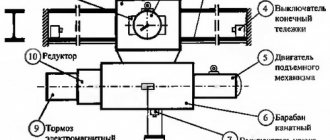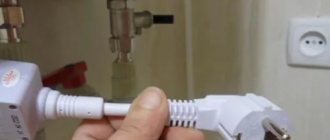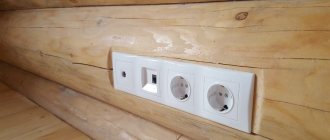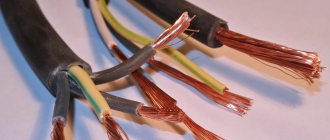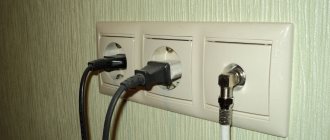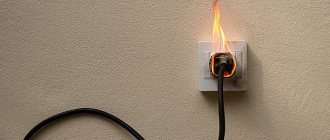In most typical apartments, there is one standard option for the location of sockets - on the wall. This is not always convenient, and meters of additional wires “spread” throughout the rooms: extension cords, surge protectors, which spoil the design and get underfoot. The issue of placing sockets in a studio apartment is especially relevant, where there may be no walls or partitions between functional areas? Solving the problem is simple: just install sockets in the floor, taking into account the future location of the equipment.
What it is?
Floor sockets are special products designed to connect equipment in the workplace. The installation of such devices allows you to optimize and secure connection points for electrical appliances in the interiors of houses, apartments or office premises.
Special hatches in the floor allow you to place connectors for a TV, telephone, computer and other equipment.
Sockets and hatches built into the floor are practical and easy to use. They have a modern appearance and easily fit into any interior.
In addition, they are ergonomic and fully meet safety requirements. But first things first.
Electrical communications planning
Shortly before renovating or building rooms, you should plan how the room or office will be built. If you plan to place objects powered by electricity or requiring access to Internet lines in places located far from walls, it is necessary to provide sockets and other connectors as close as possible to these places.
The outlet will be in the middle of the room
Currently, floors are popular in which various types of telecommunication cables can be laid. When the substrate is concreted, electrical and telecommunication sockets can be immediately made in places away from the walls.
Most often, the channels are located along the walls around the perimeter of the room in several places, and pass through the channels to the inside of the room. With a special cable pusher, additional wires can be easily pulled along existing ones.
Features of floor sockets
Floor sockets have the same electrical characteristics as conventional products (those mounted on walls). Here, a voltage of 220 Volts is also required, after which electrical equipment is connected to the outlet.
The main feature is the design and auxiliary fittings required for installation.
The floor socket kit includes:
- Housing with lid;
- Special supports for snapping;
- Cable clamp;
- Partitions, clamps and other accessories.
This configuration is sufficient to properly install the product and ensure the safety of its use. At the same time, the hatch in the floor for sockets reliably protects against mechanical influences, ingress of water or dirt.
The advantage of the designs is that other connectors can be provided inside - for connecting a telephone, Internet cable and other wires.
Everything you need is in one housing, which saves space in the room and simplifies the installation process.
Why can't I use standard sockets?
People are often confused by the rather high price of floor sockets. There are also difficulties in purchasing them: they cannot be found in every store. Then you may be tempted to save effort and money and install conventional overhead sockets in the floor. However, this is absolutely impossible to do for a number of reasons:
- Wall devices are not designed for the loads to which models installed in the floor are subjected: they are not walked on, furniture is not placed on them, etc. Conventional sockets will break very often.
- Wall models do not have moisture and dust protection, so the risk of a short circuit increases many times.
- The devices do not close the lids when not in use, which can also lead to accidents.
- They protrude from the surface and are not suitable for hidden placement; when placed on the wall it is invisible and does not cause discomfort. On the floor, even a slight protrusion will be noticeable, and you can trip and fall on it.
- The IP index does not exceed 44, which may not be sufficient for more severe floor conditions.
Thus, ordinary wall sockets, even built-in ones, are not suitable for use on the floor, so you only need to purchase special devices designed for high loads.
To avoid short circuits and fires, you need to connect the wires to the device in a plastic box, this will ensure maximum insulation.
According to version
The products in question also differ in their design options. They are:
- Made of plastic;
- Metal (using brass, steel or other alloys);
- For installation in the floor (subject to ceramic tile cladding);
- For installation in the floor with subsequent use of laminate, parquet or carpet;
- With increased resistance to moisture (IP66, IP44);
- With different installation depths;
- To accommodate one socket;
- To accommodate from two to twelve sockets.
Also, sockets (hatches) in the floor may vary in color. The following options are possible here - gray, beige, white, graphite, brass, steel or aluminum colors.
Floor sockets, retractable sockets, buy built-in sockets in the countertop in Kyiv (Ukraine)
Legrand built-in hatches are supplied with socket mechanisms incomplete. They are equipped individually at the request of the Customer with modular mechanisms of the Legrand Mosaic series. In addition to standard electrical sockets with grounding, the hatch can be equipped with computer and telephone connectors, HDMI, VGA, audio sockets, and switches. The hatch can be easily installed using the installation kit. An example of a tabletop outlet is shown below.
Pull-out sockets
One of the varieties of table furniture sockets is retractable sockets. As a rule, this is a whole block of several electrical connectors. Less commonly, the unit may also include information sockets. Since the unit is sold assembled, computer connectors are quite rare in the units. Retractable sockets for the kitchen, conference room, meeting room, and regular offices easily solve the problem of supplying electricity directly to the consumer.
Ready-made complete solutions for retractable sockets for tabletops are offered by Hager (Germany), EVOline (Germany), Bachmann (Germany), d.Point (Poland). The principle here is: connect and use. The power cord and plug are included with the retractable socket block. Some models allow you to hide the block with plugs connected to it back into the countertop. It is very convenient and functional. Products from Simon (Spain) and Schneider Electric (France) are more suitable for design solutions; sockets can be assembled into a block. Examples of installing built-in retractable sockets in a tabletop are below.
Floor sockets
Floor sockets are a very practical solution. They make it easy to organize 220V power supply in large open spaces - stages, showcases, trading floors, sports grounds, etc. Special hatches are used for their installation. The hatch and the cables suitable for it are installed/laid at the stage of pouring the floor. Hatches for floor sockets from Legrand are made of metal. They are durable and resistant to corrosion. Some models have a degree of protection against moisture penetration IP44.
Pull-out blocks and hatches can be installed in any type of floors and countertops. They are ergonomic, practical and functional, and easily fit into any interior. Hatches for floor sockets are supplied empty without filling. Mosaic series electrical accessories are installed inside each product. Thus, you can arrange and select the required number of electrical sockets, computer, telephone, TV and others, installed in the hatch in the floor.
Similar products are offered in several shapes and colors. In total, Legrand offers 5 colors: aluminum, bronze, glossy white, stainless steel and matte black. Legrand built-in floor in aluminum and bronze colors are available from warehouses in Ukraine. Other colors are imported to order, delivery time can range from 4 to 6 weeks. The most popular ones are stainless steel and bronze. The shape of the hatch determines its standard size. There are 4 of them in total: 3, 4, 6 and 8 modules. Each module can be equipped with a Mosaic series product.
A hatch in the floor for sockets solves not only functional problems, but also ergonomic problems. There are many situations where it is impossible to extend an electrical line to the desired location. Proper advance planning of the electrical supply of the premises will help prevent unexpected “surprises”. A socket in the floor in the right place will help solve a number of not only functional, but also design problems.
When choosing floor hatches for installing sockets in the floor, pay attention to its depth. At the stage of pouring the floor, it is convenient to use a special pouring form (box). It forms the necessary contour. Pay attention to the humidity in the room; you may need to do additional waterproofing. Think in advance about what equipment will be connected to each specific hatch.
This directly affects the connectors installed in it and the cables connected to it. If the Legrand floor hatch will be used only to power electrical appliances, then it is necessary to extend an electrical cable to it in the floor. To be able to replace the wiring, the cable must be laid in a pipe. We recommend laying an additional backup pipe for the future possibility of pulling another cable into it (computer, television, power from another group of consumers).
This is especially true if you have floor hatches for sockets under tiles.
Electrical columns
Modern "Open Office" type offices involve the distribution of desktops in large open spaces. Due to the lack of walls, it is impossible to organize classic hidden wiring, so electrical installation columns for sockets, hatches, and various socket blocks come to the rescue. When rearranging, the workspace changes, and the utility networks - electrical and low-current cables - must change along with it.
One of the options for organizing a network in the office is columns with sockets. They are made of aluminum, which makes them light and durable at the same time. Standard electrical installation columns can be secured using a spacer mechanism or on a heavy base. Mini-columns are attached to the floor (raised floor) using dowels or self-tapping screws. Any version of the column will look great in an office interior.
Technical characteristics and main advantages of office columns for low current and electrics: - all main fastening options - spacer mechanism, cast iron portable base, fixed base; - modern laconic design, strength and lightness of anodized aluminum, aluminum or white color (on request); - single and double (two-sided) execution;
- height from 2.5 m to 3.7 m, mini-columns - 650 mm and 700 mm.
Source: https://shop220.com.ua/categories/rozetki-v-pol
| Floor socket, floor hatches (floor hatches or floor boxes) are electrical installation products and equipment that are designed to optimize workplaces in the open interiors of apartments, houses, offices due to the ability to connect electrical (220V) and information (computer, telephone, television, USB, HDMI) to them ) cables laid in concrete or technical raised floors. Floor sockets and floor hatches for sockets are very practical and convenient, fit well into the interior, are ergonomic, and fully meet consumer requirements. In addition to the residential sector, they are also often used in premises with large open spaces - car centers (car showrooms, car washes, car service stations), concerts, theaters and sports venues, catering establishments, shopping centers, and other public premises. As a floor hatch, you can use a hatch (equipped with the required number of sockets) from the following well-known brands: Legrand (France), Simon (Spain), Ecoplast (Russia), IEK (Russia), GIRA (Germany), Bticino (Italy). As a floor socket (except for the actual floor hatches for sockets), you can use a moisture-resistant 220V socket with a cover for hidden installation (preferably made of metal) from one of the following well-known brands: ABB - BUSCH-JAEGER (Germany), Legrand (France), GIRA (Germany), Merten (Germany), Siemens (Germany), Bticino (Italy), JUNG (Germany), Simon (Spain), Schneider Electric (France), Berker (Germany), PEHA (Germany). Floor sockets and floor hatches for sockets vary: 1) by functional purpose: - floor sockets (built-in sockets with a cover, metal or plastic) - floor hatches (built-in) 2) according to version: - plastic - metal (steel, brass, other alloys) - moisture-resistant IP44, IP66 - for installation in a floor lined with ceramic tiles - for installation with the possibility of laying in the edge of the floor covering cover (parquet, laminate, carpet) - various installation depths - on 1 socket - for 2 - 12 sockets 4) by color scheme: — white — beige — gray — aluminum colors — graphite — steel colors - brass colors Below are images of floor sockets and floor hatches made in the design of famous brands. The prices of the presented floor sockets and floor hatches, as well as information about other electrical installation products of specific series, can be seen by clicking on the corresponding picture or series name. Floor socket, floor hatches LEGRAND | Hatch Legrand 89617 for 24 modules | |
| Floor box Legrand 89621 for 10 modules | Floor box Legrand 89626 for 16 modules | Legrand 89630 plastic mounting box for embedding floor boxes when installing them in poured concrete floors |
| Floor box Legrand 89615 gray with a lid with anti-corrosion coating | Floor box Legrand 89616 gray with a carpet-look cover | Floor box Legrand 89617 beige with a lid for carpeting |
| Mounting box Legrand 89634metal | Floor box Legrand 89644 3 modules | Legrand installation box 89649 for concrete floors for floor box 3 modules 89644 |
| Pull-out complete socket block Legrand 54011 aluminum color | Pull-out complete socket block Legrand 54011 in a mounting box for 3 modules | Mounting box Legrand 650390 plastic for 3 modules |
Other types of device
The main characteristics by which products can be classified include the possibility of regulation, the number of sockets in one housing, as well as the material of manufacture. The last two signs are discussed above.
As for adjustments, there are two options:
- Stationary models are floor sockets that are installed on the floor without the ability to move.
- With the possibility of fixation - devices that, if necessary, can be adjusted in height and position.
The number of sockets in a special hatch varies from 1 to 12 pieces. The material used is plastic or metal.
Socket selection
The floor connector is used for hidden installation in a horizontal plane. The cost of floor-standing models is higher than wall-mounted ones, which gives rise to the desire of some home craftsmen to build a system with their own hands using ordinary sockets.
This approach is unsafe, since wall-mounted models are inferior to floor-mounted ones in the following characteristics:
Advice! When purchasing floor-standing devices, special attention should be paid to the quality of the wiring boxes. This is especially true for their moisture resistance.
When selecting accessories, it is recommended to consider the following criteria:
Floor hatches for sockets - selection criteria
Floor hatches are the best solution when organizing a workplace if information and power cables are laid under the floor covering.
To install sockets, special hatches are used in which various types of products are mounted - 220 Volt sockets, connectors for connecting a TV, computer or telephone.
Depending on your preferences, you can choose a hatch with different depths. If necessary, it is possible to install an open socket in the floor (without a cover).
When choosing the appropriate option, it is important to take into account the operating conditions and purpose of the room. For example, when installing a floor socket on a terrace, it is necessary to install special hatches that reliably protect against moisture and dust (IP66).
In order not to make a mistake in choosing, it is worth considering the following characteristics:
- Type of flooring - raised floor or concrete. In the first case, the height of the floor is taken into account, and in the second, the thickness of the hardened mortar.
- The number of modules is 45x45, the number of different sockets (information and power), as well as other products.
- Color. There are many options to choose from, which were mentioned above (gray, beige and others).
- Terms of Use. When choosing, you should focus on the requirements for protection from moisture and dust (IP level).
- Type of material. Floor sockets can be made of various materials - plastic or metal. In the latter case it is aluminum, brass or steel.
- Delivery terms.
To avoid dismantling the hatch in the future, it is recommended to immediately decide on the principles of using the device. If over time you plan to expand the functionality of the structure, it is advisable to install a frame module in the raised floors.
If you need to power one or two electrical appliances, a small device recessed to a minimum depth will suffice.
An equally important point is the protection of the wire that goes to the outlet in the floor. Corrugated tubes are supplied with some products. Their use is desirable if there is free space between the main floor and the raised floor.
How to install sockets in the floor with your own hands
Technologically, this process is free of difficulties. But actions must be careful and careful. After all, this is working with electricity.
The power supply must be turned off before performing any operations. Then they separately check whether there is any voltage left in the network. Only after this the full installation begins.
Installing a floor unit or hatch with sockets
The design of the unit differs from a standard socket only in the number of seats. The block includes a plastic case and internal elements, which include terminals with terminals and contacts.
Hidden
The installation process will be the same regardless of whether the installation is on the wall or on the floor.
The installation is carried out not on the floor surface, but inside the socket box. Installation is carried out in the following order:
- First, the socket cover is unscrewed, then it is installed inside the box.
- The device is secured using spacer lug screws.
- The wires are connected.
- The structure is closed with a decorative panel of sockets.
Outdoor
Relevant if an open installation method is chosen.
The outdoor device is also safer if the room is decorated with wood. With this view, it becomes as easy as possible to find existing problems.
Assembly - procedure:
- A special paronite gasket is used between the socket and the base material.
- After this, fix the wiring to the terminals. A decorative cover is placed on the base.
The installation can be considered complete.
Options for selecting a hatch, with or without a cover
There are models with or without a cover, built-in. The latter option is more expensive. But these factors are chosen only depending on the personal preferences of the future owners. In addition, it is recommended to study some other characteristics:
- Degree of moisture protection. The bigger it is, the better. Low indexes are only suitable for dry rooms.
- The required depth at which the cover is made. Typically the parameter is in the range of 6-26 millimeters. The determining factors are the height of the fill or false floor, the finishing option used.
- Number of sockets inside. Modules come in pairs and singles. But they can also accommodate 4, 6, 8, 12 devices.
- The type of outlet that is used in a particular case is taken into account.
- The color is selected to match the floor covering or the interior of the room.
- Modification.
- The material from which the product is made. Aluminum and brass, plastic and steel are options that are more common. In terms of strength and wear resistance, plastic models are much inferior to metal ones. They can withstand a maximum load of 300 kilograms. But if the traffic is very high, then preference should be given to plastic. They are hardier and more durable.
- Tight fit, easy to open the lid.
- The required number of internal components.
- Conditions for future use.
How to check the operation of a floor electrical outlet?
A multimeter is enough to identify most faults.
This is a device that measures voltage. He is also called a tester. Simple models that are sold in specialized stores for 200 rubles are suitable for home use.
Two types of such devices are available:
- switches.
They used to be popular, but began to fade into the background only with the advent of electronic analogues. They are distinguished by a simple structure inside and the absence of a battery. The small size of the scale makes taking readings very inconvenient.
- electronic.
They are distinguished by accuracy and convenience, although they are more expensive compared to the previous ones. They have additional functions that make it easier to examine wires and sockets themselves for faults.
Mounting housings
Before carrying out installation work, it is worth preparing free space. With frame kits, you need to secure the product using self-tapping screws or screw-type clamps.
The set of fasteners directly depends on the material from which the base for fastening the structure is made.
In the case of using a poured coating, it is possible to install an inexpensive plastic housing to a depth of about 8 cm or a galvanized kit with a immersion of 20-30 cm. The latter solution is suitable for industrial premises.
As an example, a galvanized kit is often used for output from special-purpose cable routes.
The greatest difficulties are associated with installing sockets in a concrete floor. The reasons are as follows:
- The installation niche will have to be knocked out, which requires considerable effort and time.
- During the work, you cannot do without an impact drill or hammer drill, with the help of which you can create the necessary mounting holes.
At the final stage of installation, the cover is attached using brackets and clamps.
Device installation instructions
Installing a socket in the floor is quite simple; you can do all the steps yourself. Installation does not require special skills or equipment.
- First, choose the location where the outlet will be located.
- Draw a cable channel with wires to the installation site of the socket.
- Further actions depend on the floor material. A groove of a suitable size is simply cut into the wooden one. The hatch is secured in this hole. With a concrete floor the process becomes more complicated. The filling will be done first. A special box for the device, which is usually included, is installed on the floor. Fill the floor with the mixture and let it dry. After hardening, carefully remove the box.
- The socket body is installed into the finished niche and secured using the included accessories.
- The socket is connected to the electrical network.
- The installation of the socket is completed by installing the protective cover.
When the device is fixed, it is necessary to check its functionality, as well as the quality of installation. Then they find out how tightly the covers close and protect the outlet from water penetration.
Floor-standing devices are suitable for large open spaces, as they allow you to get rid of unsightly wires, as well as for rooms filled with objects, since they help unload the room and organize the workplace.
What the market offers - main manufacturers
When choosing floor hatches, you should give preference to well-known manufacturers - Legrand (France), Ecoplast (Russian Federation), Simon (Spain), IEK (Russian Federation), Bticino (Italy), as well as GIRA (Germany). Also popular are companies such as Vergokan, Efapel, DKC, JSL and ABL-Sursum.
If a floor socket is required, you can use products from the following brands - JUNG, GIRA, Siemens, RENA and Berker (all Germany), Bticino (Italy), Schneider Electric (France) or Simon (Spain).
Legrand
Today, the manufacturer Legrand is a leader in the production of electrical devices. So it is not surprising that the products of this brand are in greatest demand. The main difference is the large equipment.
It was previously noted that floor-mounted cases can contain up to 12 sockets, but in the case of Legrand, up to 24 different sockets are available to users.
To ensure greater security, dividing panels are used that separate the functional points from each other.
The differences between the brand’s products include a number of stylistic features. Thus, a socket in a Legrand floor can have a decorative design and be made to match various textures - mosaics, carpet, stone or wood.
Legrand metal hatches:
- Round metal hatch with one module 45x45 mm. The device has an IP protection rating. Color is stainless steel.
- Metal hatch with one module 45x45 mm. The product has a degree of protection IP44 and is made of metal. Color: stainless steel. The shape is rectangular.
- Metal hatch with two modules 45x45 mm. The degree of protection from moisture and dust is IP44, the device is made using metal. Color: stainless steel.
- Metal hatch with one module. Has dimensions 45x45 mm. Degree of protection - IP The product has a round shape, is made of metal, has a bronze color.
- Metal hatch with one module. Dimensions - 45x45 mm. Moisture and dust protection level IP The product is made of metal, color - “bronze”.
- Metal hatch with two modules. The dimensions of the device are 45x45 mm. Degree of protection - IP The product is made of metal and has a bronze color.
Legrand plastic hatches:
- Floor hatch for 3 modules. The product is made of gray plastic. There is one mechanism for connecting electrical receivers. Dimensions - 45x22.5 mm.
- Floor hatch, 6 mechanisms. The features of the model include the presence of a plastic case and a lid made of stainless steel. Number of mechanisms - 6. Module dimensions 45x45 mm. The installation depth is 7.5 to 10.5 cm. The cover has an anti-corrosion coating.
- Floor hatch, 6 mechanisms. The dimensions of the device are 45x45 mm. Installation is carried out to a depth of 7.5 to 10.5 cm. The product is made of plastic and has a gray color.
- Floor hatch, 9 mechanisms. The dimensions of the device are 45x45 mm. The box is installed to a depth of 7.5 to 10.5 m. The material used is plastic, the color is beige.
- Floor hatch, 12 mechanisms. Like most of these models, the dimensions of the device are 4.5 by 4.5 cm. Installation is possible at various depths in the range from 7.5 to 10.5 cm. The material used is plastic. The surface is beige.
- Floor hatch for 4 mechanisms with dimensions 45x45 mm and two mechanisms for 45x22 mm. The installation depth is 6.4 m. The product is made of plastic and has a gray color.
Device security level
A number of factors are taken into account here:
- fire safety;
- degree of protection from moisture and dust;
- ability to withstand mechanical loads;
- the maximum weight that the product can support.
Thus, metal sockets do not burn or melt, can withstand weights from 200 kg to 4 tons, and are well protected from mechanical damage, so they are installed in crowded places.
The plastic device is suitable for home use. It can withstand weight up to 300 kg, is resistant to mechanical stress, and does not support combustion.
The degree of dust and moisture protection is shown by the IP Index (Ingress Protection Rating). The minimum value is 22, the maximum is 69. High-quality dust- and moisture-proof floor sockets have an IP index of 67, i.e. almost the maximum.
